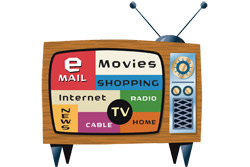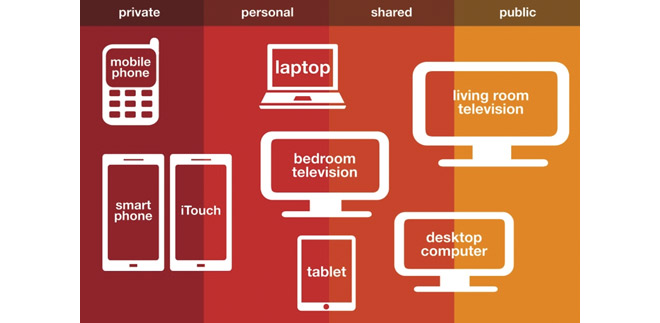Europe's online source of news, data & analysis for professionals involved in packaged media and new delivery technologies

FEATURE: The future is here - how people interact with technology
That, in a nutshell, is the message that came loud and clear from the recent consumer research Rovi conducted. "In 300 interviews and 70 3-hour in-home sessions spanning the United States, Canada, Germany and Italy, we sought to get a deeper understanding of how people interact with their technology and entertainment in the home," explains CHARLES DAWES, Rovi's Product Management Director.
We wanted to go into people's homes and sit at the back of the living room and observe how they watch television. We selected mainstream people, rather than 'early adopters' or 'experts.'
Our objective was four-fold: measure the success of device integration, understand changes and trends in consumption, evaluate social desires and current market solutions, and determine the impact of our products and solutions.
Many people were excited with what they can do now with new technology they could not do five years ago, but they felt it took a lot of work and understanding of technology. Some were overwhelmed with the number of devices and services they had to upgrade to and the money they had to spend.
All consumers dream of getting everything, everywhere, anytime; at the push of a button, the content ought to be there. The nag is that content owners are a little leary about this ease of access.
A TV is not a computer
Every home has assigned a CTO - a chief technology officer - the person that ensures everything is working. Consumers expect to sit down in front of a TV and have it work perfectly. But operations such as searching, browsing, streaming, buffering are not TV-like operations with which they are familiar.
Our research shows that 92% of respondents discover that the technology they bought has unrealised value - it was not what they expected and cannot figure out how to make it work. It is bringing the worst features of the computer experience into television. Indeed, 96% believe too many ?connected? solutions bring the bad of computers into the TV.
Such things like software upgrades, enduring an on-screen buffering icon, and waiting for downloaded content, seem like the downsides of using a computer when all people really want is to sit down in front of a TV and enjoy.
While consumers may seek new content and new experiences, they are not dissatisfied with the television they are getting today over-the-air, via cable or satellite. There is always something worth watching or at least something that will entertain some members of the family. Essentially, most people like the way things are. Indeed, while 41% of US households own a digital video recorder (DVR), a whopping 89% of television is still watched live. Clearly, people just want to sit down and escape!
Participants regularly commented on the guilt they feel when they are not able to enjoy all of the content available on their DVR. Most will bulk erase content and hope to better manage their recordings in the future.
Multi-faceted content
Content is a different thing to different people.
An event. Although this is less frequent, one should remember that people plan events around content.
An escape. More frequently content is an escape, a mini-vacation from reality. What you are watching is not nearly as important as the fact that it takes you away. When people turn on the television, they want to relax, not make decisions.
A commodity. Content is still used as a commodity. Something (really anything) that is available right now, so I can have a 30-minute break. A lot of people have no interest in preserving content. They will not want to see again what they have seen once, thus, it does not need to be permanently stored.
An educator. The recognition that content can be genuinely an educator came as a surprise. Generally, in phone interviews, respondents will claim to watch a lot of documentaries though in reality they are likely to turn to less highbrow material. So, when we sat down with people and observed what they were watching, it was obvious a lot of people were learning from their television. Planet Earth and the likes bring them where they would have never ventured if it was not for the programme, which is made all the more vivid by the ever-bigger living room screen.
Content is generally selected based on the time available. Though they have recorded feature films or TV programmes they wanted to see, on weekdays, 91% of people say they bypass movies for a quick 30-minute episode watched live. Usually, though, they end up watching multiple 30-minute programmes and thus could have watched a full-length recorded movie.
Technology expands the modes of consumption. Catch-up TV is strong outside the US and particularly in the UK. Many British respondents say they watched, for the first time, Lost when the series was no longer available. Ditto with The West Wing. Seventy-two percent of participants have watched a ?new? series, which is no longer available. It does not matter that it's not current content; it's new to them and that?s fun! New technology is being used to discover content people have heard is very good, but did not watch it when it was first scheduled on TV.
The attitude vis-à-vis Video on Demand is intriguing. A large amount of VOD content is free. Episodes of The Sopranos can be watched for free on a set-top box because people have already paid a subscription to HBO. However, there is a deep-seeded perception that VOD is for a fee. There is reluctance on the part of parents to let kids access VOD content for fear they will be charged. Indeed, more than 50% of participants in our research are unwilling to navigate the VOD catalogue for free content because of concern about getting charged!
Content consumption - split persona
The multitude of devices for content access reveals the extent to which all consumers have a split persona. The desired content depends on such factors as the consumer's mode of consumption, location, company, timing, type of device, time allocated and mood.
For example, perhaps you like the TV program, Dexter. It might not be your spouse?s cup of tea - let?s say your spouse likes Mad Men. You may not particularly like Mad Men, but you may enjoy sitting with your spouse so in that instance, you will watch the program as a shared experience. If the children are around, perhaps you all watch Disney programmes, but it may not be what you would choose to watch on your own.
There are shows couples will want to watch together and will not watch alone as they would have the feeling of cheating. Indeed, according to 88% of respondents, watching 'couples content' without your significant other feels like cheating!
There is very little content where three generations will sit on the couch together to watch - except sports. Ninety-one percent of people gather around sporting events with family, extended family, and friends, at some point over the year.
In multiple-person households, 97% of participants manage three types of content across all the devices they use: content they watch alone, content they watch with spouse or child, and content they all watch together.

Social network on television?
While importing social networks' interaction on the big screen is now made possible with Internet-connected TVs, it appears to be a 'no-go' area for consumers. We discovered that to be social on the TV is not necessarily something people want. Social interaction happens in phone calls, in face-to-face meetings, via texting, but it does not happen on the screen via a keyboard. To prove this point, our research reveals that 91% of people (under 60) use text as the primary social channel for their closest relationships.
The likelihood of an honest opinion being shared is inversely proportional to screen size!
I will text my friend the show I am watching on a smartphone. I might possibly write something on Facebook on a PC and I will watch the show on TV without external communication. I might perhaps text while I am watching television, but will not use Facebook. Ninety-five percent of participants did not feel comfortable with Facebook or Twitter applications on the large living room TV screen.
I will communicate with others on my personal devices. On a bigger screen, my neighbours will see what I write so I will never communicate with my friends or family in that fashion. A tablet is usually used by several members of the family with a single login, so I am not going to share personal thoughts on a tablet.
The teenagers told us they would never access Facebook on a TV because their parents will immediately know what all their friends are up to. And their parents told us they would never access Facebook on the TV because they do not want their children to know what they actually know about them!
Where content is enjoyed says a lot about intent. The living room is the hearth and content here is often shared. The bedroom is a place for 'private airings,' an area to escape. The kitchen is an area to accomplish other tasks and content is used as a radio might be.
Sometimes people like to watch movies on a big screen with their family. Other times they like to watch by themselves--reclaiming their personal time and their own space. In a nutshell, 'content anywhere' is not just about catching up, but it's also about allocating a new space for content consumption.

CHARLES DAWES is an authority in digital television product management, having been involved in managing the development of converged content experiences for many years. Charles began his career at Cable and Wireless, responsible for EPG development. Prior to Rovi, Charles held the position of Product Management Director at UPC/Chellomedia, overseeing UPC's Digital Television Product Development across their European footprint. Contact: www.rovicorp.com.
This is one of many editorial features included in the annual DVD and Beyond 2012 magazine. Ask for your free copy.
Story filed 03.12.12




















